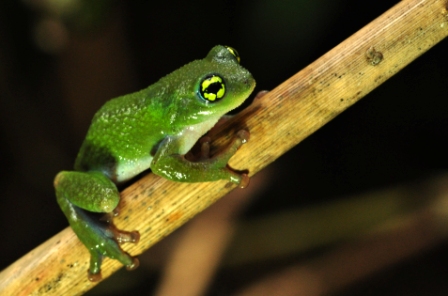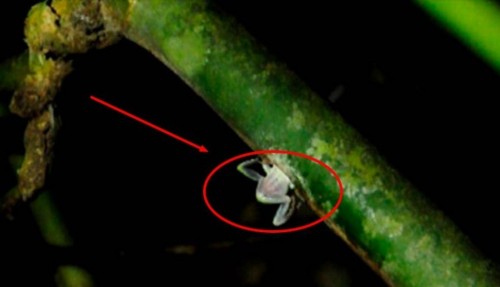The bubble-nest frog or white-spotted bush frog is a Critically Endangered (CR) species found in the Western Ghats of India that was discovered again after 125 years. Now, researchers have also revealed a peculiar behavioral pattern of the frog. They observed that this white frog enters into a hollow living bamboo, lays its eggs there and stays in there as it nurtures its eggs into baby frogs and cares for them; a method of direct development bypassing the tadpole stage.
 Raorchestes chalazodes, Image via biotropica.org
Raorchestes chalazodes, Image via biotropica.org
These observations were recorded at Kalakad Mundanthurai Tiger Reserve in the Western Ghats by Seshadri K S, a PhD student at National University of Singapore, his thesis advisor, Asst. Prof. David Bickford and collaborator Dr. Gururaja. K V. from the Indian Institute of Science.
Tiny amphibian
Raorchestes chalazodes, also known as white-spotted bush frog or bubble-nest frog is a tiny green frog measuring less than three centimeters in length. Belonging to the Rhacophoridae family of tree frogs; it is a nocturnal, arboreal species found in the underwood of tropical moist evergreen forest and may occur in secondary or disturbed habitat. It is assumed that the species breeds by direct development.
For over a century there was no sighting of this small amphibian and hence was assumed to be extinct. It was first discovered in 1876 in the erstwhile Travancore state and then again seen 125 years later in the Cardamom Hills. Now it is listed as “Critically Endangered” on the IUCN Red list of Threatened Species.
Inside the bamboo nest
The adult frogs lay their eggs inside the bamboo reed; stay on inside to guard the eggs from predators such as ants and keep them moist. For the eggs and the frogs to survive, it is essential that the bamboo (known as “flute bamboo” or “bamboo reed”- Ochlandra travancorica) be alive and have one or more natural openings made by insects or other animals.
As dusk approaches the male frog croaks out its mating call and enters the bamboo through a small opening (about 5-10mm long and 3-4mm wide). From within he continues to call which lures the female too inside the bamboo. She lays six to seven eggs there which directly develop into baby frogs. The tadpole stage is done away with in these frogs. The caring father that he is, the male looks after the eggs remaining inside the bamboo. While they are in there, other females too might mate with the male and lay five to eight eggs. Though few in number, the eggs are large in size (about 5mm in diameter) considering the average size of an adult frog of the species.
The discovery of their unique habitat and mode of direct development came by accidentally.
“We had heard frogs calling from inside a bamboo and, one night, went in search of them. On seeing a frog vocalizing on a bamboo leaf, we began making observations and the frog squeezed itself into a narrow opening nearby,” said Seshadri. “Several night searches later, we were able to observe eggs and froglets inside the bamboo by carefully splitting it open. However, this discovery is just the beginning. It has opened a whole new world of questions that are waiting to be answered. As to what transpires inside the internode, it’s still a mystery,” he added.
Amphibians are known to exhibit diverse means of reproduction and this has been classified as the 41st mode in all frogs. The classification of reproductive modes is done on the basis of,
a) Where the eggs are laid
b) Whether the eggs develop directly into small frogs and,
c) Whether parental care is observed
The evolution of direct development could be an indication that these amphibians are showing increased terrestrial affinity than aquatic, spending more of their life on land than in water.
Direct developing eggs are possibly the most prominent aspects of frogs as they do not need any free flowing water to develop.
“The Western Ghats hotspot is known to be an important site for amphibian radiation and several novelties have been uncovered in the last two decades. While species diversity has increased, very little ecological information has been added. The recent discoveries of interesting behavior such as “Foot Flagging” in the Dancing frog (Micrixalus kottigeharensis), and clay nest building in Potter frog (Nyctibatrachus kumbara) are cases which indicate that there is much more to be discovered about amphibian behaviour in India and S E Asia” said Dr. Gururaja K V.
More Related Stories,
Frog in Western Ghats Affected by Logging even after 40 Years
The Wild Wisdom Quiz Book- Review








Very interesting observation. New information about life cycle it just proves the saying “Servival of the fittest”
Yes, Sudheer it is interesting and while there are some other frog species known too which bypass the tadpole stage, this certainly is a new find in India!
Wow. What an interesting find!
Very interesting indeed Shilpi!